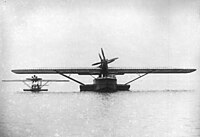Dornier Do A
| Dornier Do A | |
|---|---|
 Libelle II (Wnr. 117) in the Deutsches Museum |
|
| Type: | Flying boat |
| Design country: | |
| Manufacturer: | |
| First flight: |
August 1921 |
| Number of pieces: |
16 |

Under the names Dornier Do A , Libelle I and II , the aircraft manufacturer Dornier Metallbauten , based in Manzell on Lake Constance , built a total of 14 single-engine small flying boats from 1921 to 1929 , most of which were exported to Sweden, Brazil and New Zealand, among others , Australia, Japan and the Fiji Islands. There were also two copies made by CMASA in Marina di Pisa. Due to their size, the dragonflies were the ideal means of transport for water-rich areas, as they could land and take off again on small lakes and rivers.
Description of the dragonfly I
The dragonfly was a high -wing aircraft in all-metal construction, the rear wing area and the rudder surfaces were covered with fabric. The flat keeled, provided with a stage hull was in more against each insular divided rooms and had on both sides of the patented Dornier -Flossenstummel for the floating stability. Steel runners built into the keel also enabled take-offs and landings on snow or ice surfaces. In the hull below the wing there were three seats, two in front, next to each other with double controls , the third behind. The three-part structure consisted of a central section on canopy struts that also accommodated the motor. Attached to it were the two outer wings, each supported by two struts for connecting the fin stub. The wing halves could be folded back for transport and storage. The drive was provided by a 55 hp five-cylinder Siemens & Halske Sh 4 radial engine with a two-bladed wooden propeller. The fuel housed in the fuselage was conveyed by a pump driven by the airstream into a drop tank installed behind the engine.
The first flight of serial number (Wnr.) 31 (without aircraft registration ) took place on August 16, 1921. Six more of this version were built, with the registration numbers D-326 (Wnr.32), D-327 (36), D-352 (37), D-275 (38, went to Sweden, with engine Siemens & Halske Sh 5 ), D-274 (39) and D-328 (40).
Changes to dragonfly II
This model had a structure largely identical to that of Dragonfly I ; however, it had an elongated bow to better protect the crew from splashing water. With the same accommodation of the three occupants, the controls on the right seat could be switched off with the aid of a clutch. The span was increased by 1.3 m. Here too the wings were foldable. Two more powerful motors were now available as a drive. Either the English four-cylinder in-line Blackburn Cirrus Mk III or the seven-cylinder Siemens Sh 11 , both with an output of 85 hp.
Of the seven Libelle II flying boats built, only one, the D-907 (61), stayed with Sportflug GmbH in Germany. In addition to the Wnr. 54, which went to Japan, all the others (Wnr. 101 to 104 and 117) were exported to these countries. One of them, heavily corroded, was discovered in 1978 on the Fiji Islands, brought back to Germany and restored to an exhibit.
From the Libelle II a land version equipped with a wheeled chassis with the designation Spatz (Wnr.41) was developed in 1922 . The only model built was so badly damaged when it was flown in that it had to be scrapped.
Technical specifications
| Parameter | Data of the dragonfly I | Data of the dragonfly II |
|---|---|---|
| crew | 1-3 | |
| length | 7.2 m | 7.5 m |
| span | 8.5 m | 9.8 m |
| Wing area | 14 m² | |
| height | 2.3 m | |
| Empty mass | 400 kg | |
| Takeoff mass | 650 kg | |
| drive | 1 × Siemens & Halske Sh 4 ; 55 HP (40 kW) | 1 × Siemens & Halske Sh 11 or Blackburn Cirrus Mk III; 85 hp (63 kW) |
| Top speed | 120 km / h | 145 km / h |
| Service ceiling | 1600 m | |
| Range | k. A. | k. A. |
"New" dragonfly
The Dornier GmbH held by Iren Dornier , grandson of Prof. Claude Dornier , has developed an aircraft along the lines of dragonfly named Dornier S-Ray 007 ; the first flight took place in 2007. Although the aircraft has the same size and design concept as the dragonfly, it is made entirely of carbon fiber reinforced plastic and, unlike the "old" dragonfly, is also an amphibian that can be found on water and on land can take off and land.
See also
literature
- Dornier Foundation for Aviation and Space Travel (Ed.): Dornier. Plant history and aircraft types . Delius Klasing, Bielefeld 2009, ISBN 978-3-7688-2610-5 .
- Günter Frost, Karl Kössler, Volker Koos: Dornier - From the beginnings to 1945. HEEL Verlag, 2010, ISBN 978-3-86852-049-1 .
Web links
- Thomas Wilberg: Dornier Libelle II. The Virtual Aviation Museum, accessed on May 20, 2015 .
